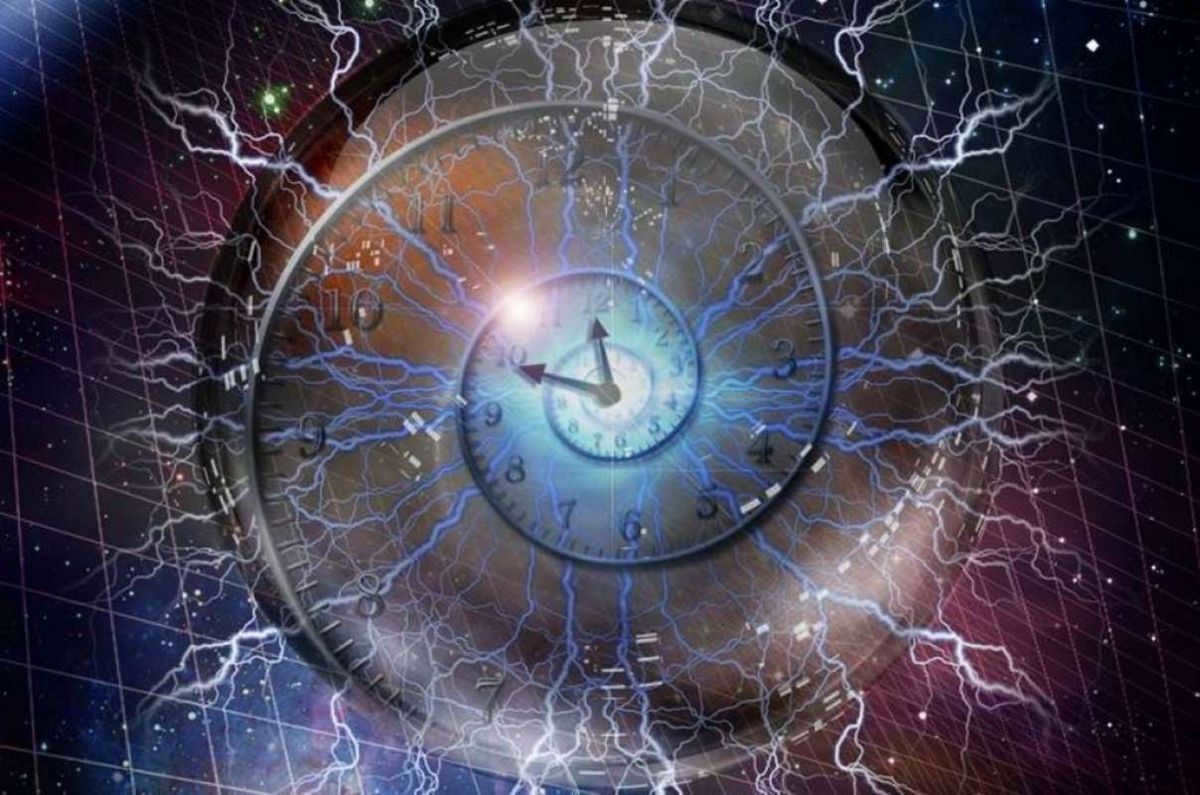Time has always been a profound enigma for both philosophers and physicists. An intriguing explanation for our observations of the universe and our perception of time comes from the concept of a block universe model.
Your existence is situated within the fabric of space-time. Each instance of your life unfolds within a specific location in space-time. In essence, this is the essence of the block universe model.
According to the block universe theory, the universe is akin to an immense block in which all possible events occur, regardless of time or location. Consequently, the past, present, and future coexist simultaneously and possess undeniable reality.
Is this achievable?
The concept has the capability of having four dimensions: three dimensions that deal with space, such as length, height, and width, and an additional dimension that deals with time. This becomes easier to comprehend if we envision the representation of the concept as a three-dimensional rectangle or cuboid.
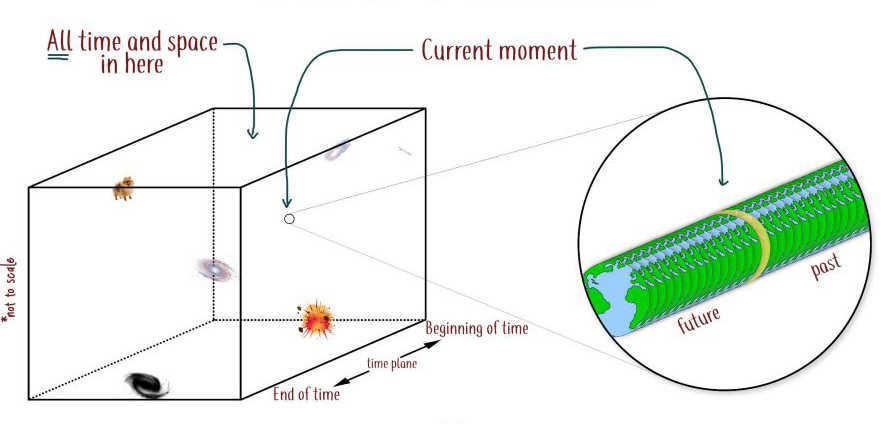
The Universe can be visualized as a cuboid with two dimensions representing the spatial dimensions of height and width. The third dimension, which is not depicted in the diagram, can be represented by the length of the cuboid, symbolizing time. In this analogy, the Big Bang is located at one edge of the cuboid, while the other edge represents the final moment of the Universe, often referred to as heat death.
Inside the cuboid, every event that has ever occurred can be found. The arrangement of these events within the cuboid mirrors their arrangement in space-time. This means that every event, including significant moments like your birth and death, as well as the present moment as you read this article, exists somewhere within this block.
Time appears static in the block universe
At times, it may seem that the current moment is the present, the previous day is the past, and the following day is the future. There are also instances where the present moment seems to shift – tomorrow it will feel like the coming day is the present, and yesterday felt like yesterday was the present!
From our perspective, time moves or progresses. However, in the block universe concept, time doesn’t move anywhere. In other words, there is no fixed present moment in the block universe, and the notions of “past” and “future” are relative.
Consider the concept of “here.” I am here. While reading this article, you might be thinking, “I am here.” Even though your “here” differs from someone else’s “here.”
According to the block universe model, discussing the concept of “now” is essentially the same as discussing the concept of “here.”
Let’s say that last week you made plans with a friend to meet up at a local coffee shop for a pleasant conversation over a delicious cappuccino. However, your friend ended up arriving late, and upon their arrival, you exclaimed, “You’re finally here!” Similarly, many years ago, Caesar might have uttered to himself, “I am currently crossing the Rubicon.”
Both of these statements hold true. This is because when we refer to the present moment – or “now” – we are referring to the specific point in time in which we currently exist. Since we are always situated somewhere, every individual is simultaneously in the present moment and in a physical location known as “here.”
According to the perspective of the block universe, there exists the concept of time or temporal relationships such as “before” and “after”. These relationships hold true regardless of one’s position.
For instance, the dinosaur Art is positioned before the dog Bobik. The relationship between Art and Bobik remains valid irrespective of whether we are positioned before Art or after Bobik.
Considering the above, it is quite conceivable to comprehend the notion of the past and the future. In this model, just as “now” is defined by the time at which the object is situated, “past” refers to any time prior to that point, and “future” refers to all times or events subsequent to the object’s location.
If time is considered as another dimension, similar to spatial dimensions, does that imply that we have the capability to traverse through time?
In brief, the answer is affirmative. Nevertheless, it is important to note that this process is far more intricate than traversing through space. The ability to travel through time requires advanced technology and can be both challenging and costly, making it impractical for us at the current moment. However, it is not beyond the realm of possibility, particularly within the framework of the block universe model.
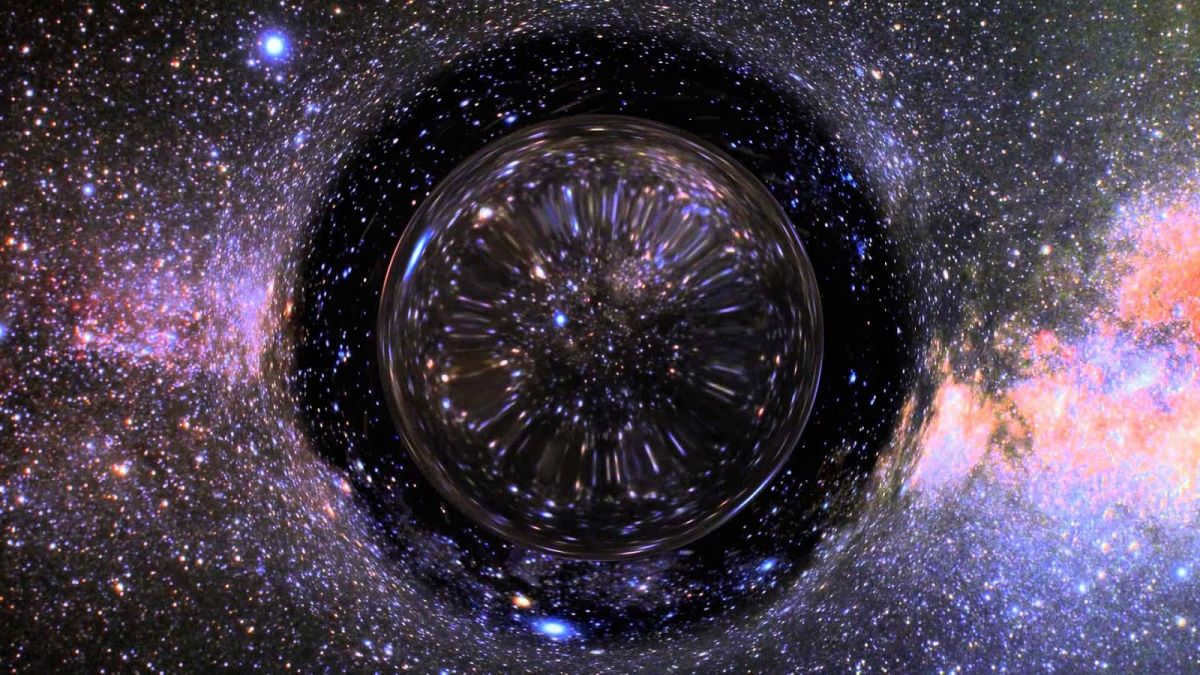
We are aware that when we travel at extremely high speeds, time slows down, allowing us to journey into the future. By reaching speeds that are close to the speed of light, it becomes possible to travel noticeably further into the future. Moreover, we have theoretical knowledge on how to travel back in time, utilizing wormholes as shortcuts through the fabric of space-time.
If time travel is possible, can we alter the past? The answer is no. Such an act would create contradictions, and contradictions do not exist. In the block universe model, the past holds no distinction from the future or the present.
Everything is relative: what constitutes the past for you may be the future for someone else. Therefore, when traveling to the past, you are essentially journeying into someone else’s future. Consequently, the past will not be any different from the present.
What will occur if you journey to the past within the block universe? You will emerge from the time machine and survey the surroundings, taking a leisurely stroll. You will engage in interactions with individuals and inhale the atmosphere. Evidently, this will have an impact on the specific time you reach. You will inadvertently crush some ants, engage in conversations with people from that era, caress horses, and provide sustenance to donkeys, among other activities.
Your behavior in the past will essentially mirror that of the present. Nevertheless, you will not alter it. Just as consuming a couple of sandwiches tomorrow morning instead of oatmeal does not modify the past, it merely solidifies it: traversing into the past does not bring about changes, it merely reinforces what has been and what currently is.
Feeling Lost?
Let’s recap. Whatever actions you take tomorrow will simply shape tomorrow into what it is and has always been. Similarly, whatever actions you took in the past have shaped the past into what it is and always has been.
If you were to travel to the past, you would become a part of it. However, it is important to note that you have always been a part of the past.
The events that occurred within the timeframe are constant and unchanging. So as a time traveler, you wouldn’t just suddenly materialize in the past. You have always existed in the past.
Whatever actions the time traveler takes, they will not alter anything within the timeframe. On the contrary, the actions of the traveler in any given time contribute to shaping that specific time and other periods as well.
As a result, we are aware that certain endeavors we attempted in the past did not yield successful results. We are also aware of the historical fact that Hitler rose to power in the 1930s. Therefore, if we were to hypothetically travel back in time from the future in an attempt to prevent this event, it is evident that we would have already been unsuccessful in doing so.
Undoubtedly, the concept of a block universe is inherently controversial. However, despite the considerable controversy surrounding it, the block universe theory is regarded as one of the most promising approaches to reconciling our cosmological understanding of time with our ordinary everyday experiences. One thing is undeniable: time holds more complexity than what initially meets the eye.
Chemists possess knowledge of over a hundred million substances, yet all of these substances are ultimately composed of atoms belonging to only 118 chemical elements. Naked Science elucidates how the entire Mendeleev table originated from the fundamental and seemingly mundane element of hydrogen. Spoiler alert: it is not solely attributed to the existence of stars!
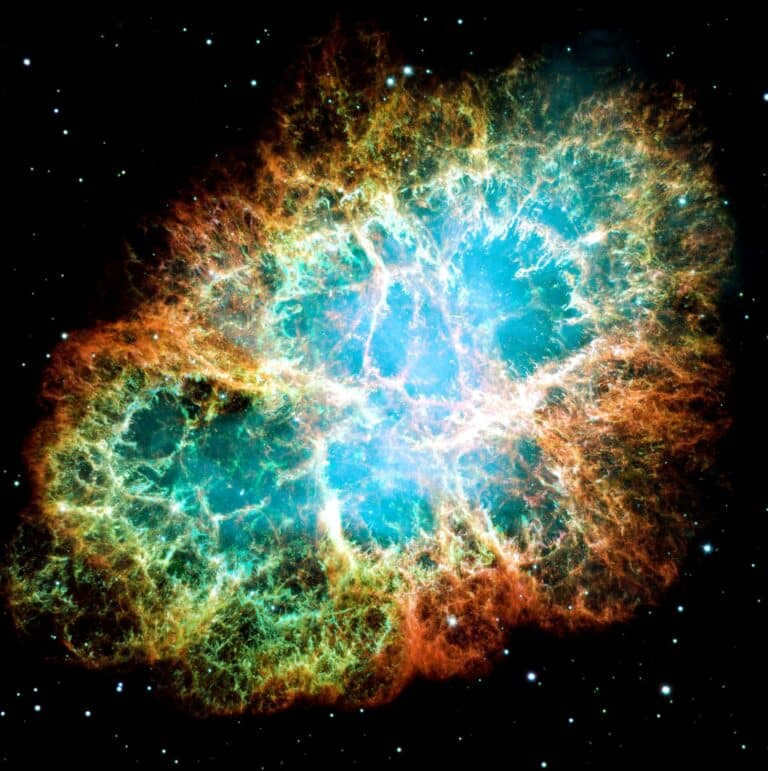
The Crab Nebula is a well-known remnant of a supernova explosion. It is highly recognized for its unique appearance and has been extensively studied by NASA, ESA, J. Hester, and A. Loll from Arizona State University.
Have you ever wondered where the chemical elements that surround us, including ourselves, originated? The answer lies in the stars! This is a common fact that many people are aware of. However, there is more to it than just the stars. The chemical diversity of the Universe was influenced by various events such as the Big Bang, supernovae, neutron stars, and even cosmic rays. It may sound overwhelming, but we will simplify it for you.
Space lego
The imagination is overwhelmed by the vast number of atoms: a glass of water contains more atoms than there are glasses of water in the world’s oceans. If each atom were unique and individual, the chaos would be incomprehensible. Thankfully, all atoms follow the same organization: they consist of a nucleus and electrons orbiting around it. The nucleus is composed of positively charged protons and neutral neutrons.
The hydrogen atom possesses the simplest nucleus, consisting of only one proton. The next simplest element is helium, which contains two protons in its nucleus. The number of protons can be easily identified by its corresponding element number on the periodic table.
What about neutrons? A small fraction of hydrogen nuclei, less than 0.1%, contain neutrons in addition to a single proton. This type of hydrogen is known as deuterium, and it has one neutron in its nucleus. There is also another type of hydrogen called tritium, which has two neutrons in its nucleus. However, tritium is radioactive and undergoes rapid decay. In general, isotopes of an element differ in the number of neutrons they have. While all elements have isotopes, the focus of this discussion will be on the isotopes of hydrogen and helium. Helium, like hydrogen, has isotopes with different numbers of neutrons. The most common isotope of helium is helium-4, which has two protons and two neutrons in its nucleus. There is also a rarer isotope called helium-3, which has two protons and one neutron in its nucleus.
Astronomers have made a groundbreaking discovery by detecting the presence of isopropanol, a type of alcohol, in a cloud of cosmic gas. This compound is considered to be one of the most intricate organic substances ever detected in interstellar space. To commemorate this momentous finding, Naked Sci has decided to pay tribute.
A hub of variety
In the present day, there are 118 elements that can be found on the Mendeleev table, although some of them have been artificially synthesized (and efforts to create new elements are still ongoing). So, how many of these elements occur naturally? Reference materials provide varying answers, ranging from 90 to 98. The key factor here is the method of counting: certain radioactive elements were initially produced in a laboratory setting, and later it was revealed that they are also found in rocks, albeit in minuscule amounts and for brief periods of time.
Despite the fact that there are at least 90 elements on Earth, the majority of its mass, about 98%, is made up of only six elements: oxygen, silicon, aluminum, magnesium, calcium, and iron. These six elements, known as the geochemical six, play a crucial role in the composition of the Earth. On the other hand, there is another group of six elements, known as the biochemical six, which are essential for the composition of living cells. These elements include hydrogen, carbon, nitrogen, oxygen, phosphorus, and sulfur. However, living organisms require a variety of other elements in order to function properly.
When compared to the vastness of the cosmos, our planet is a veritable treasure trove of chemical diversity. The universe as a whole is relatively monotonous, with hydrogen accounting for 91% of all atomic nuclei and helium making up almost 9%. All other elements make up less than 1% of the total. If we consider mass rather than the number of nuclei, the situation is slightly less dismal since hydrogen and helium are very light. However, the difference is still minimal.
If you find yourself taken aback and disheartened by the uniformity of chemicals in the vast expanse of the Universe, fear not: there is a fascinating explanation awaiting us.

The process of creation
Immediately following the occurrence of the Big Bang, the temperature reached such extreme levels that it became impossible for protons and neutrons to exist. However, due to the rapid expansion of the Universe, energy began to spread out across larger and larger areas, resulting in a cooling of matter. Within the first second of this cooling process, protons and neutrons started to form.
Let us not forget that protons are the nuclei of hydrogen, specifically its most common isotope known as protium. Thus, the creation of the Universe filled in one slot on Mendeleev’s periodic table.
During that time, a series of significant reactions occurred in laboratories, which are considered to be the most important:
Deuterium + deuterium = tritium + proton
Deuterium + deuterium = helium-3 + neutron
Deuterium + tritium = helium-4 + neutron.
Deuterium + helium-3 = helium-4 + proton.
These reactions were responsible for the formation of most of the modern helium. Despite the fact that stars are known for producing helium, their contribution is relatively small compared to primary nucleosynthesis. Interestingly, approximately 80% of the atomic nuclei in the Universe are not associated with galaxies or stars.
At this point, the creation of elements came to a halt. The concentration of helium was insufficient for it to serve as the building block for new elements, as it does in stars.
While it is true that helium can form lithium, beryllium, and boron, these elements are produced in very small quantities. Unfortunately, these nuclei are easily destroyed in thermonuclear reactions, which is why there are fewer of them in the Universe compared to other lighter elements like iron. The presence of these elements in the Universe poses a challenge for explanation. One possibility is that they were created when cosmic ray particles collided with interstellar hydrogen. Additionally, they may have also been synthesized during supernovae events, which we will discuss later.
A novel method of carbon synthesis is described that does not rely on Goyle resonance, a unique state of the carbon nucleus. This suggests that the existence of carbon and intelligent life in the universe is not impossible.
We are celestial remnants
The universe would be a monotonous amalgamation of hydrogen and helium if it were not for the innovative fusion reactors – stars. The initial ones ignited the cosmos countless eons after the colossal explosion known as the Big Bang.
Throughout the majority of its existence, a star undergoes a process similar to the one the universe experienced during the era of primary nucleosynthesis: it converts hydrogen into helium. However, the sequence of reactions is notably distinct and intricately complex. This is due to the fact that, unlike in the early cosmos, stars do not possess an abundance of free neutrons. An extranuclear neutron has a lifespan of just a few minutes.
What occurs when the hydrogen supply is depleted? The outcome varies depending on the star’s mass. Stars with less than 0.5 solar masses reach the end of their lives. Their cores are not sufficiently hot and dense for helium to undergo thermonuclear reactions. Our Sun, to our delight, will continue on: it will generate carbon, nitrogen, and oxygen. And even more massive stars synthesize elements all the way up to iron, which has 26 protons in its nucleus.
After that, stars’ fusion processes become ineffective. It is challenging for heavy nuclei to collide with each other due to the electrical repulsion of the numerous protons.
By the way, most of the stellar thermonuclear reactions have not yet been replicated on Earth. Creating the necessary conditions is too difficult. However, they can be calculated theoretically, and the calculated results align well with the observed composition of the Universe.
Astronomers have observed an unexpected phenomenon: the temperature of certain old white dwarfs is higher than anticipated. This increase in temperature is attributed to the thermonuclear reactions occurring in the remnants of their hydrogen shells.
Creating Heavy Elements in the Universe
However, these first 26 elements account for less than a third of the 90 elements that exist in nature. So, how were the remaining elements formed?
Well, physics has a clever solution to this problem. Remember when we mentioned the scarcity of free neutrons in stars? However, neutrons do appear in certain nuclear reactions. These neutrons then collide with atomic nuclei and become bound to them. Unlike protons, neutrons are uncharged and do not repel the atomic nucleus, allowing them to easily attach themselves to it.
And thus, when the particles of the nucleus have already embraced it within their intimate circle, the neutron performs a cunning maneuver. It emits an electron and transforms into a proton! This results in an additional proton residing in the nucleus, signifying the birth of the subsequent chemical element. With the customary, modest neutron flux, this process unfolds gradually, hence earning the moniker “s-process” derived from the English term “slow”.
The s-process takes place within red giant stars and has the capability to generate elements as heavy as bismuth (with 83 protons). However, the pace is truly leisurely: it requires a millennium to transmute an iron nucleus into a lead nucleus (boasting 82 protons). Simultaneously, elements ranked between 84 and 89 (ranging from polonium to actinium) exhibit radioactivity. Their nuclei decay at a faster rate than the s-process can attach a fresh proton to them!
There are two types of supernovae, by the way. Type Ia is linked to the thermonuclear explosion of a white dwarf, while the rest are connected to the collapse of massive stars (if you desire more information, Naked Science provides it). Both of these events, along with other catastrophes, initiate the r-process.
This is not merely a hypothesis. Astronomers are well aware of numerous supernova remnants and have extensively researched their makeup. Additionally, three years ago, scientists found heavy elements at the location where neutron stars collided.
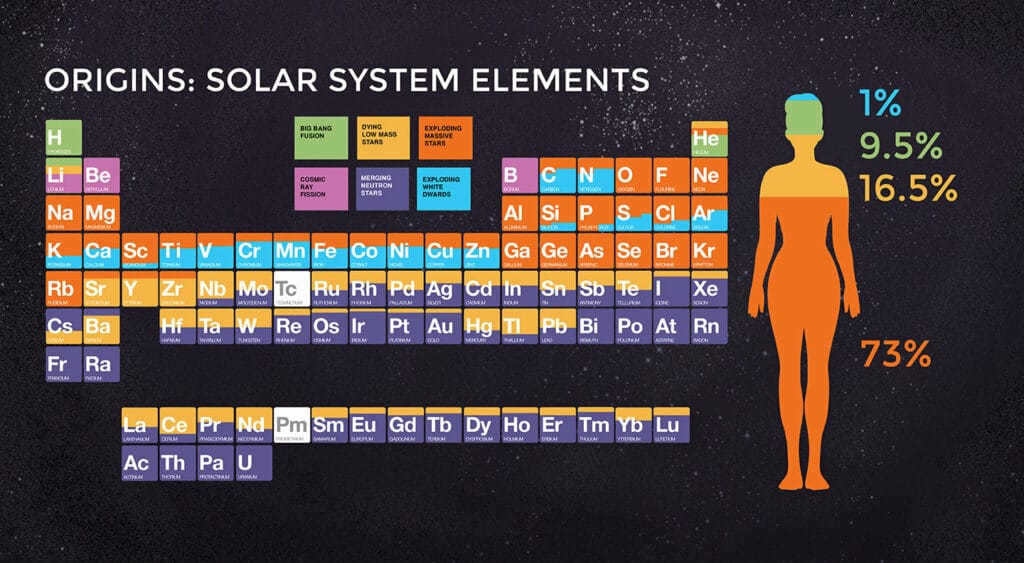
Delivery of pre-made mixtures
The substance of the burnt-out celestial body follows two different paths. A portion of it will disperse throughout the interstellar space and potentially serve as material for future stars and planets. The remaining portion will be permanently preserved within the remnants of the celestial body, such as a white dwarf, neutron star, or black hole. However, it should be noted that white dwarfs occasionally undergo Ia supernovae explosions, transforming into interstellar dust. Additionally, neutron stars sometimes collide and merge, losing a small fraction of matter in the process. Nevertheless, these catastrophes are rare exceptions rather than the norm. In most cases, the matter that enters the stellar remnants becomes inaccessible to the rest of the universe.
The larger the star, the more matter it releases back into the environment. Unfortunately, most of the Sun’s mass will be preserved in a white dwarf, serving no purpose. However, massive stars can distribute up to half or even two-thirds of their mass into space even before they explode as supernovae. Therefore, we should thank these wasteful but heavy luminaries for providing the oxygen in our air and the sodium in our blood, rather than our efficient lungs.
It is truly astonishing how much effort the universe had to exert in order to create the building blocks for the rocky planets and their inhabitants. Nevertheless, it is only because of the ceaseless work of this chemical factory that there are individuals who can be in awe of it.
Regarding the subject
The extraordinary attractor: an enigma of the cosmos and impending catastrophe
Astrophysicists have stumbled upon a rare “fossil cloud” originating from the inception of the universe.
Existence may have originated during the early stages of our vast universe
Trending
Scientists specializing in genetics have traced the lineage of Etzi the “ice man”
A groundbreaking investigation has revealed that a man whose remains were preserved in the frozen Alpine region for countless millennia was both bald and possessed a dark complexion.
City trading was common among Bronze Age kings
An extraordinary discovery has been made by Turkish archaeologists who have unearthed a one-of-a-kind tablet featuring an Akkadian inscription that reveals an unusual economic situation that existed almost four thousand years ago.
Scientists have developed a method for transmitting sound in outer space
A group of physicists from Finland has successfully demonstrated the practicality of the phenomenon known as “vacuum phonon tunneling” in transmitting sound waves. This groundbreaking discovery shows that under specific conditions, sound vibrations can traverse a vacuum gap and transfer from one object to another.
Researchers Discover an Ancient Creature Known as the “Ice Mouse” from the Time of Dinosaurs
A recent study has unveiled the existence of a minuscule animal that inhabited the northern regions of Alaska approximately 73 million years ago. What makes this creature unique is its ability to survive in frigid climates without undergoing hibernation. Physically resembling a shrew, this extraordinary being weighed less than an empty soda can made of aluminum.
Chemists have made a discovery that Vlad Tepes Dracula shed tears of blood
A group of scientists from around the world has uncovered proof that Vlad Tepes, also known as Count Dracula, experienced a rare ailment that resulted in his tears being mixed with blood.
Kings in the Bronze Age engaged in city trading
Archaeologists from Turkey have stumbled upon a one-of-a-kind tablet containing an Akkadian inscription that detailed an extraordinary economic situation nearly four thousand years ago.
This is the first major export shipment of its kind from India. Until now, advanced Indian military equipment has not been sought after internationally.
Researchers have debunked the “ten thousand step rule”
It is frequently stated that walking at least ten thousand steps per day is crucial for maintaining good health. Nonetheless, a recent extensive study has indicated that even shorter walks can be beneficial, with just four thousand steps being sufficient to lower the risk of mortality.
Paleontologists have identified what may be the largest creature ever to have existed
Enormous remains discovered in South America are attributed to an extinct marine mammal, with a potential weight of up to 340 tons – surpassing the current record holder, the blue whale, by one and a half times.
Opinions



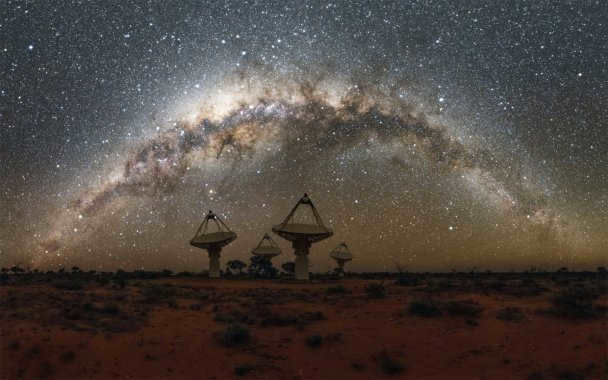
A group of astronomers from the United States and Egypt recently conducted research to determine the amount of matter present in space. Their findings, which were published in the scientific journal Astrophysical Journal, shed light on this intriguing question.
Space: A Unique Blend
What materials make up the Universe? Of course, it consists of stars and planets. There is also interstellar gas, which is roughly equal in mass to the stars. In the vast space between galaxies, there are occasional atoms of intergalactic gas. Although rare, this gas actually weighs four times as much as the stars and interstellar gas combined. However, it is not the main ingredient in the cosmic mixture. Scientists have been aware of the existence of another component, known as dark matter, for many years. This substance cannot be observed through telescopes, but its presence is strongly felt through its gravitational effects. It influences the movements of stars within galaxies and the interactions between galaxies within clusters.
However, the prevailing opinion among experts is that the majority of dark matter does not primarily consist of atomic nuclei. According to compelling calculations, it is believed that there couldn’t have been enough baryons formed after the Big Bang. Instead, it is hypothesized that the bulk of dark matter is composed of undiscovered particles that have yet to be observed by experimental physicists. This enigmatic substance is commonly referred to as non-baryonic dark matter. It is important to note that the non-baryonic nature of the vast majority of dark matter has not been definitively proven. However, this hypothesis holds such authority that it is incorporated into the dominant model of the Universe, known as the ΛCDM-model.
Nevertheless, that’s not everything. The primary component of the “cosmic vinaigrette” happens to be dark energy, which is responsible for the accelerated expansion of the universe. The presence of this extra acceleration is widely accepted, and it earned Brian Schmidt and Adam Riess the Nobel Prize in Physics back in 2011. However, scientists are still debating the nature of the dark energy and what exactly causes it. The majority of experts believe that it is a certain characteristic of the vacuum or a pervasive field. However, there are also more unconventional theories.
Exquisite ratios
What is the quantity of baryonic matter (the matter we can see, along with some dark matter), non-baryonic dark matter, and dark energy present in our universe? How are these components proportionately combined, like a well-blended salad? This inquiry holds significant importance as it determines various aspects, such as the expansion rate of the Universe and the formation of galaxies and their clusters.
First and foremost, let’s elucidate the method by which matter and energy are compared. The crux of the matter is that any amount of mass harbors energy, the precise quantity of which can be determined using the renowned formula E = mc 2 . Moreover, it is worth noting that this quantity is truly remarkable: within a solitary gram of matter lies an astounding twenty kilotons in the equivalent of TNT. By converting mass into energy, cosmologists ascertain the respective contributions of baryonic matter, non-baryonic matter, and dark energy to the overall energy of the Universe. Such calculations have been conducted on numerous occasions and through various approaches. However, the authors of the novel study employed their own distinct methodology.
During the early stages of the world, matter was distributed more evenly across space compared to its current state. The gravitational force acted upon this matter, causing it to come together and form galaxies and clusters. The occurrence and mass of these clusters were heavily influenced by the amount of matter present in the Universe. As the amount of matter (both baryonic and non-baryonic) increased, the frequency of galaxy clusters and their mass also increased. To study this phenomenon, the researchers used computer modeling to simulate the formation of galaxy clusters under different quantities of matter in the Universe. They then compared their simulated results with observational data to validate their findings.
This method is not novel and has already been widely adopted. However, the authors have introduced a significant modification to it. They have devised and implemented a technique that aids in determining whether a specific galaxy is part of a cluster. This poses a challenge, as our observation from Earth provides a two-dimensional perspective instead of a three-dimensional one. A stellar system that appears to be associated with a cluster might actually be positioned in front of or behind it.
By utilizing their algorithm, the scientists individually computed the mass of each cluster. This sets their research apart from the previous studies, which relied on the average mass of multiple clusters. Additionally, the astronomers depended on their own catalog of galaxy clusters, known as GalWCat19. This comprehensive catalog includes over 1800 clusters, encompassing a grand total of more than 38500 galaxies. The authors compiled this catalog by utilizing data from the expansive SDSS survey and specifically selecting the brightest and closest clusters. Notably, these clusters are in close proximity, with their light reaching Earth within a timeframe of no more than 2.5 billion years. This proximity allows the researchers to disregard any potential impact from the expansion of the universe and any subsequent changes that may have occurred within these clusters throughout time.
The Universe is a Vast Empty Space
After conducting extensive calculations, scientists have determined that the total energy in the universe is primarily derived from dark energy, accounting for a staggering 69% of the overall energy. This includes both visible matter, the baryonic component of dark matter, and its non-baryonic counterpart. Interestingly, previous research has also revealed that the fraction of familiar baryonic matter in the universe is a mere 20%, further emphasizing the emptiness of our world.
These findings align closely with other studies, which also attribute a significant portion of the cosmic energy to dark energy. Estimates range from slightly over 70% to around 68%. Regardless, it is undeniable that this enigmatic force remains the largest source of energy in the vast expanse of the universe.
The reliability of different methods can be inferred from the coincidence of their results. In essence, this suggests that the organization of the Universe is indeed consistent.
An illustrative example is provided by the authors. Let’s suppose that all matter, including non-baryonic matter, is composed of hydrogen. How many atoms would be required to account for its observed quantity? On average, only six atoms per cubic meter of space. To put things in perspective, there are more atoms in a single glass of water than there are glasses of water in the Earth’s oceans.

Man perceives the Universe as infinite, immutable, and everlasting. Nevertheless, modern concepts tell a different story. Let’s acquaint ourselves with the crucial details regarding the composition of the Universe and briefly follow its progression.
Composition of the Universe
Hypotheses regarding the structure and evolution of the Universe have been proposed since ancient times. Even during the emergence of the Copernican doctrine, it became evident to many individuals intrigued by this subject that the Earth was merely a speck in the vast expanse of space. As astronomy progressed, it was discovered that the distance to the farthest objects in the Universe is approximately 45.7 billion light years ($4.3\times10^9$ m). At this scale, the Universe exhibits a uniform filamentary arrangement. The matter in the Universe is distributed within filamentary superclusters of galaxies, with regions spanning a few million light-years in size and devoid of luminous matter.
A super cluster is a collection of galaxy clusters that range in number from two to twenty. Each individual cluster is a system of several galaxies that are held together by gravity. These clusters have a diameter that spans tens of millions of light years and a mass that is approximately $10^-10^$ times that of the sun.
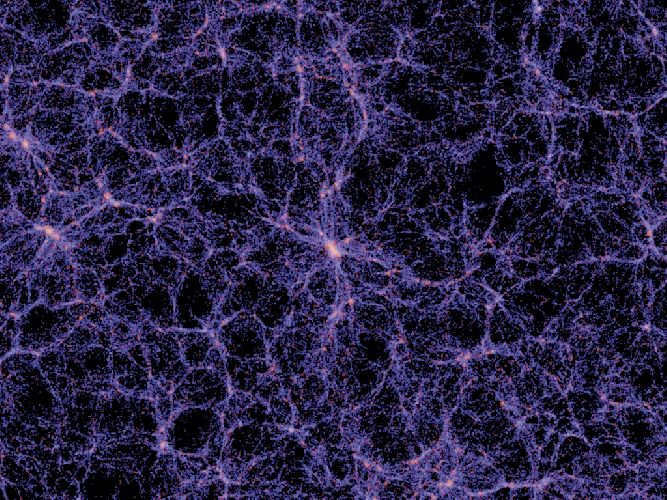
Development of the Cosmos
Research on the Cosmos reveals that its dimensions are growing over time – the Cosmos is expanding. The expansion of the Cosmos originated 14 billion years ago from a concentrated and compact condition known as the Big Bang.
The sequence of events in the development of the Universe can be described in the following way. During the initial stages of existence (ranging from zero to $ ^ $c, known as the Planck epoch), matter possessed a density of approximately $ ^ $ kg per m³ and a temperature of around $ ^ $K. At this time, quantum effects played a dominant role, and all fundamental interactions were unified into a single overarching interaction.
Early Phases of the Development of the Universe
This era commenced with the divergence of gravity from the overall electronuclear interaction. The matter density during this period decreased to $10^$ kg per m³ and the temperature decreased to $10^$K. The separation of gravity triggered symmetry breaking in the youthful Universe and laid the groundwork for its inhomogeneity. At that particular moment, the Universe itself was a quark-gluon plasma.
By the time of $10^$c, the temperature in the Universe had decreased significantly, causing free quarks and gluons to amalgamate into hadrons, which include protons and neutrons, the fundamental constituents of matter in the future Universe. The strong interaction separated from the electroweak interaction. Hadrons became stable, with particles and antiparticles coexisting simultaneously.
It was not until the plasma had cooled to $10^c$ that particles and antiparticles started to annihilate, resulting in the production of a significant number of photons. A slight asymmetry in the system led to an excess of matter compared to antimatter.
As the density and temperature continue to decrease, nucleosynthesis becomes possible. Protons start to form nuclei, while electrons occupy specific positions within electron shells. This phenomenon typically occurs approximately 300,000 years after the occurrence of the Big Bang.
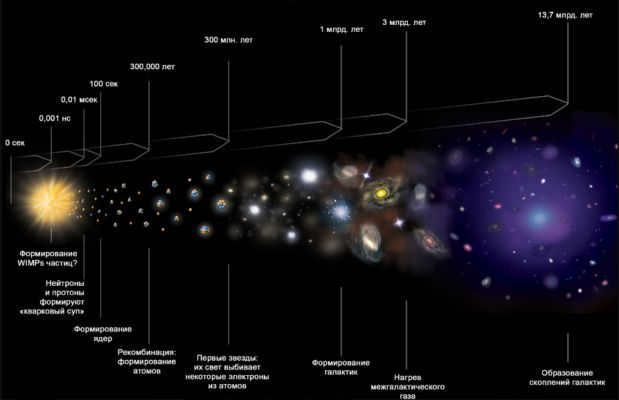
The contemporary period
The process of nucleosynthesis concludes with the creation of 75% hydrogen, 25% helium, and small amounts of other elements in the cosmos. Around 800 million years after the Big Bang, the era of matter commences. The gas present throughout the universe starts to develop irregularities and clumps. At this point, the average temperature in the universe drops to thousands of kelvins, which is not sufficient for nuclear reactions to occur.
Nevertheless, as the protostellar clouds become denser, the pressure and temperature within their cores begins to rise once more, resulting in the initiation of thermonuclear reactions and the appearance of the first stars in the universe. These stars are then drawn together by gravity and movement, forming galaxies, which in turn come together to create clusters of galaxies.
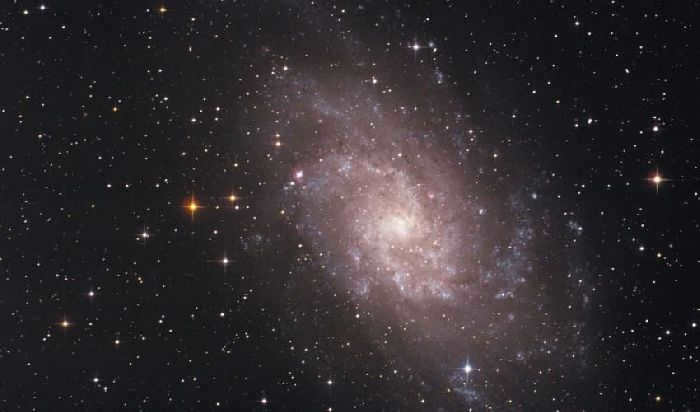
What Knowledge Have We Acquired?
The Big Bang event occurred approximately 14 billion years ago and marked the birth of the Universe. Over time, as the Universe expanded, its density and temperature decreased, which allowed for the emergence of matter, gas clouds, and ultimately, stars. When observing the Universe on a grand scale, we can observe a network-like structure composed of superclusters and vast regions devoid of emitting matter.

What can we learn about the cosmos and its nature? The cosmos is an immense and incomprehensible realm that appears surreal and intangible to the human mind. However, in reality, we are encompassed by matter that knows no bounds in space and time, capable of assuming countless forms. In order to grasp the true magnitude of the expanse beyond our planet, the organization and structure of the universe, as well as the intricate processes of evolution, we must venture beyond the limits of our own perspective and view the world from a fresh vantage point.
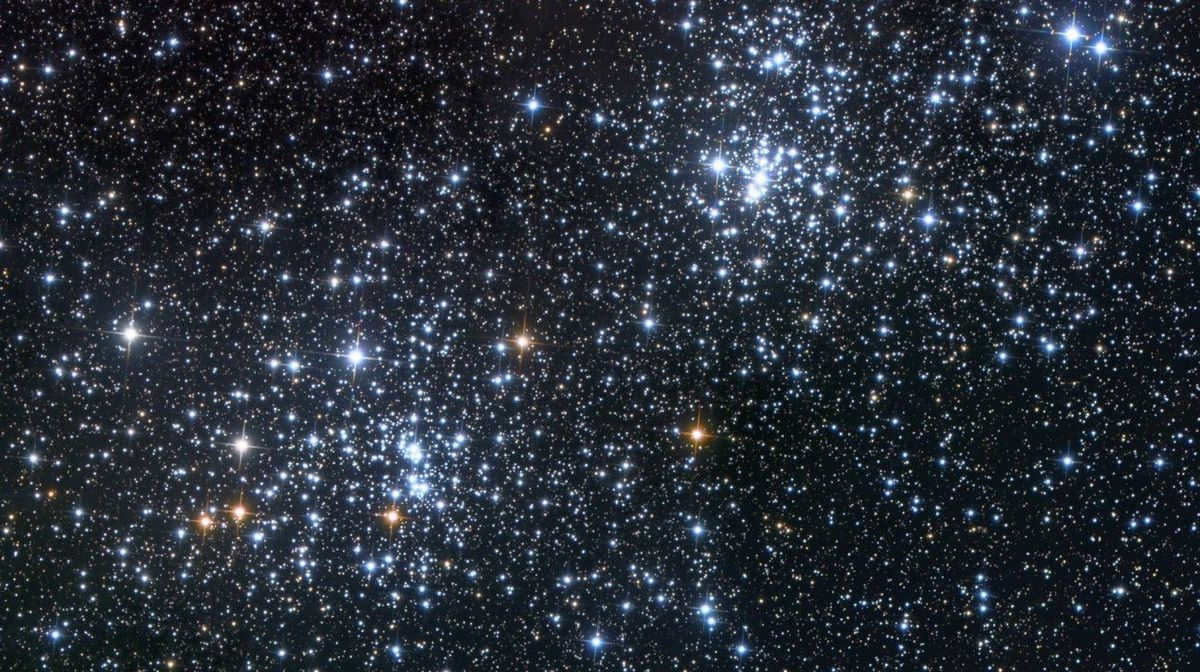
Observing the immense expanse of the cosmos from our vantage point on Earth
The origin of the Universe: its initial stages
The celestial realm that we witness through our telescopes represents only a fraction of the stellar Universe, also known as the Megalaxy. The dimensions of the Hubble cosmological horizon are truly staggering – approximately 15-20 billion light years. These figures are approximations as the Universe is in a constant state of expansion throughout its evolution. This expansion occurs through the dissemination of chemical elements and relic radiation. The structure of the Universe undergoes continuous transformation. Clusters of galaxies manifest in space, while the Universe is teeming with countless celestial bodies, including billions of stars. These stars form the building blocks of the immediate cosmic vicinity – star systems that harbor planets and satellites.
Where did it all begin? How did the universe come to be? The universe is believed to be about 20 billion years old. It is possible that the origin of cosmic matter was a hot and dense protomatter, which eventually exploded. The explosion caused tiny particles to form and scatter in all directions, still moving away from the center to this day. The prevailing scientific theory, known as the Big Bang theory, provides the most accurate explanation for the universe’s formation. The matter that emerged from this cosmic catastrophe was a diverse mass made up of small and unstable particles that collided, separated, and began to interact with one another.
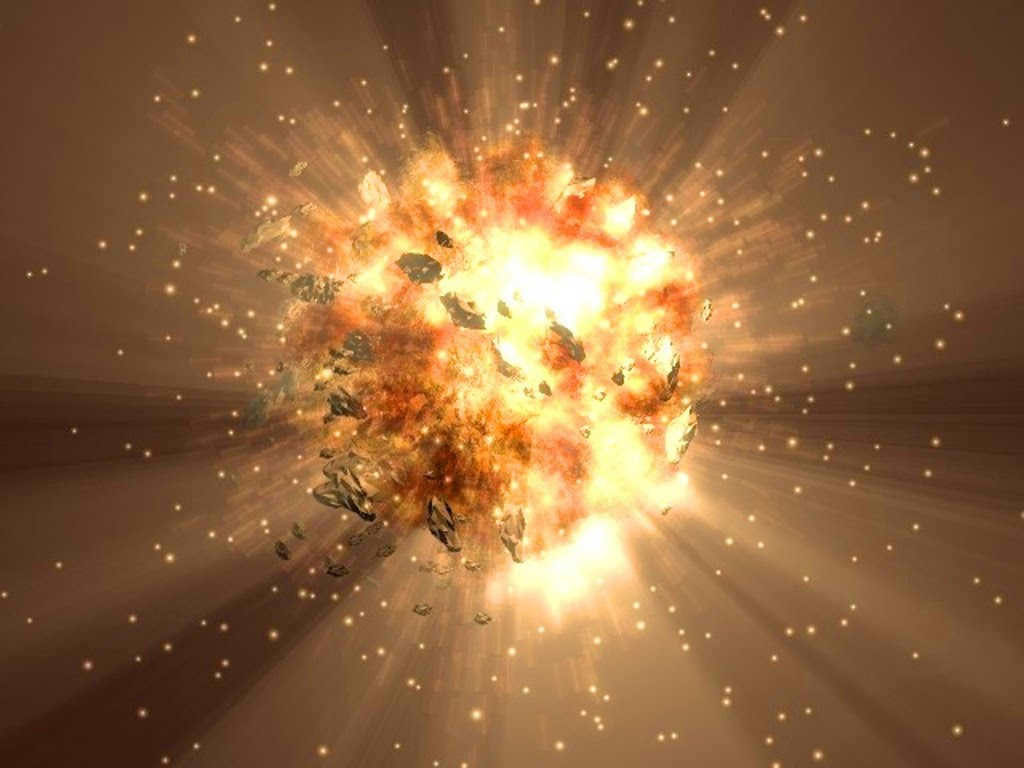
The theory of the origin of the Universe is known as the Big Bang, explaining how it was formed. According to this theory, the Universe started with a specific amount of matter that exploded with immense force, dispersing mass throughout space as a result of certain processes.
After a certain period, which is just a moment in cosmic terms but millions of years according to the Earth’s calendar, the phase of space materialization occurred. What exactly is the composition of the Universe? The scattered matter started to gather together into clusters, both big and small, which eventually gave rise to the initial components of the Universe – massive gas clouds that would later become the birthplaces of stars. In most cases, the process of object formation in the Universe can be explained by the laws of physics and thermodynamics, but there are still certain aspects that remain unexplained. For instance, why does matter become more concentrated in one part of space while it is much more sparse in another part of the Universe? The answers to these questions can only be obtained once we gain a clear understanding of the mechanism behind the formation of cosmic objects, regardless of their size.
Currently, the mechanism behind the creation of the Universe can be attributed to the interplay of the fundamental laws governing its existence. The emergence of protostars, responsible for the eventual formation of galaxies, can be attributed to both gravitational instability and energy distribution across different regions. Essentially, as matter continues to expand, the gravitational forces at play initiate compression processes. This leads to the concentration of gas particles within clouds, resulting in the formation of new structures. The primary building blocks of this immense construction are molecular hydrogen and helium.
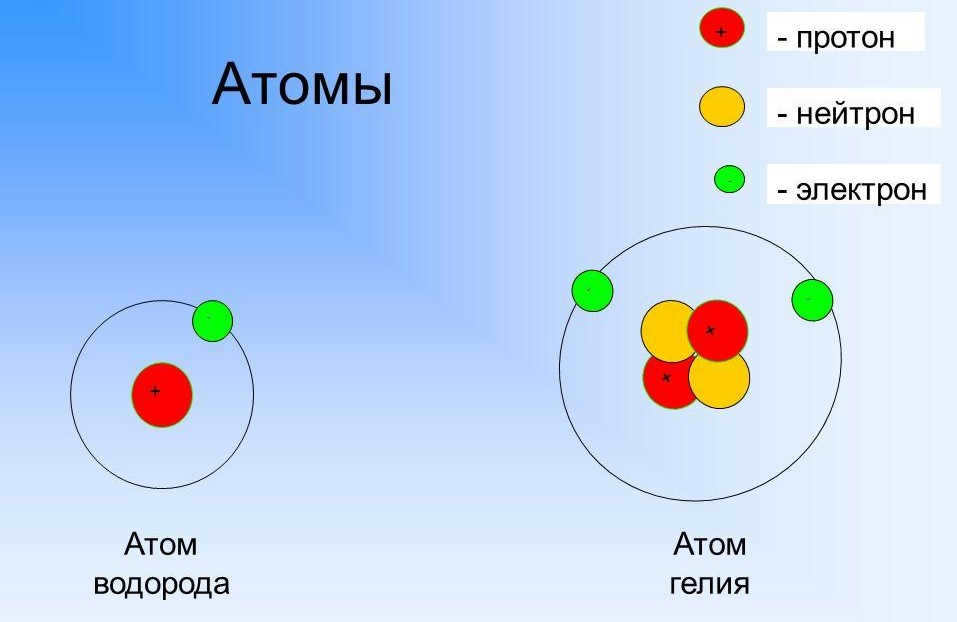
The elements that make up the Universe are the fundamental components that later formed the objects in the Universe.
Subsequently, the laws of thermodynamics come into play and initiate processes of decay and ionization. The hydrogen and helium molecules break down into atoms, which then form the core of a protostar under the influence of gravitational forces. These processes follow the laws of the Universe and take the shape of a chain reaction, occurring in every corner of the Universe, filling it with billions and trillions of stars.
The Evolution of the Universe: Key Moments
Within scientific circles, there exists a hypothesis regarding the cyclical nature of the events that shape the history of the Universe. After the explosion of protomatter, clusters of gas emerged as the birthplace of stars, leading to the formation of countless galaxies. However, as the Universe progresses through different phases, matter begins to gravitate towards its original, condensed state. Thus, the explosive expansion of matter in space is eventually followed by compression and a return to a superdense state – the starting point. This cycle continues indefinitely, with birth followed by ultimate demise, repeating itself for billions of years and beyond.
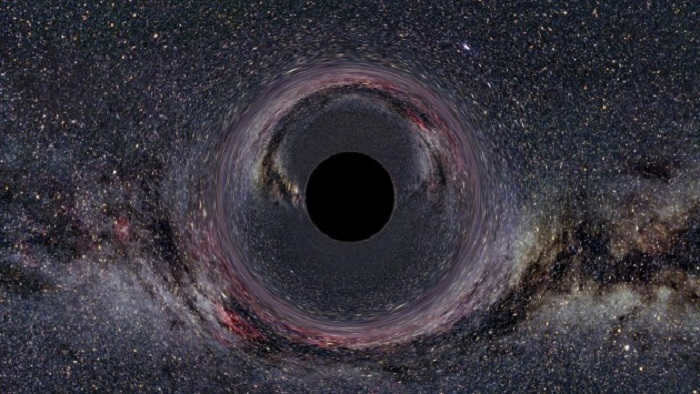
The cyclic evolution of the Universe encompasses both its beginning and its end.
While the formation of the Universe remains an unanswered question, it is important to delve into its structure. As early as the 1930s, it became evident that cosmic space is comprised of galaxies, massive formations, each host to its own stellar population. These galaxies, however, are not stationary entities. The velocity at which galaxies move away from the hypothetical center of the Universe is constantly changing, evident in the convergence of some galaxies and the increasing distance between others.
From the perspective of the duration of life on Earth, all of the aforementioned processes occur at a sluggish pace. However, from the standpoint of scientific theories and hypotheses, these evolutionary processes transpire rapidly. In a general sense, the evolution of the Universe can be categorized into four distinct eras:
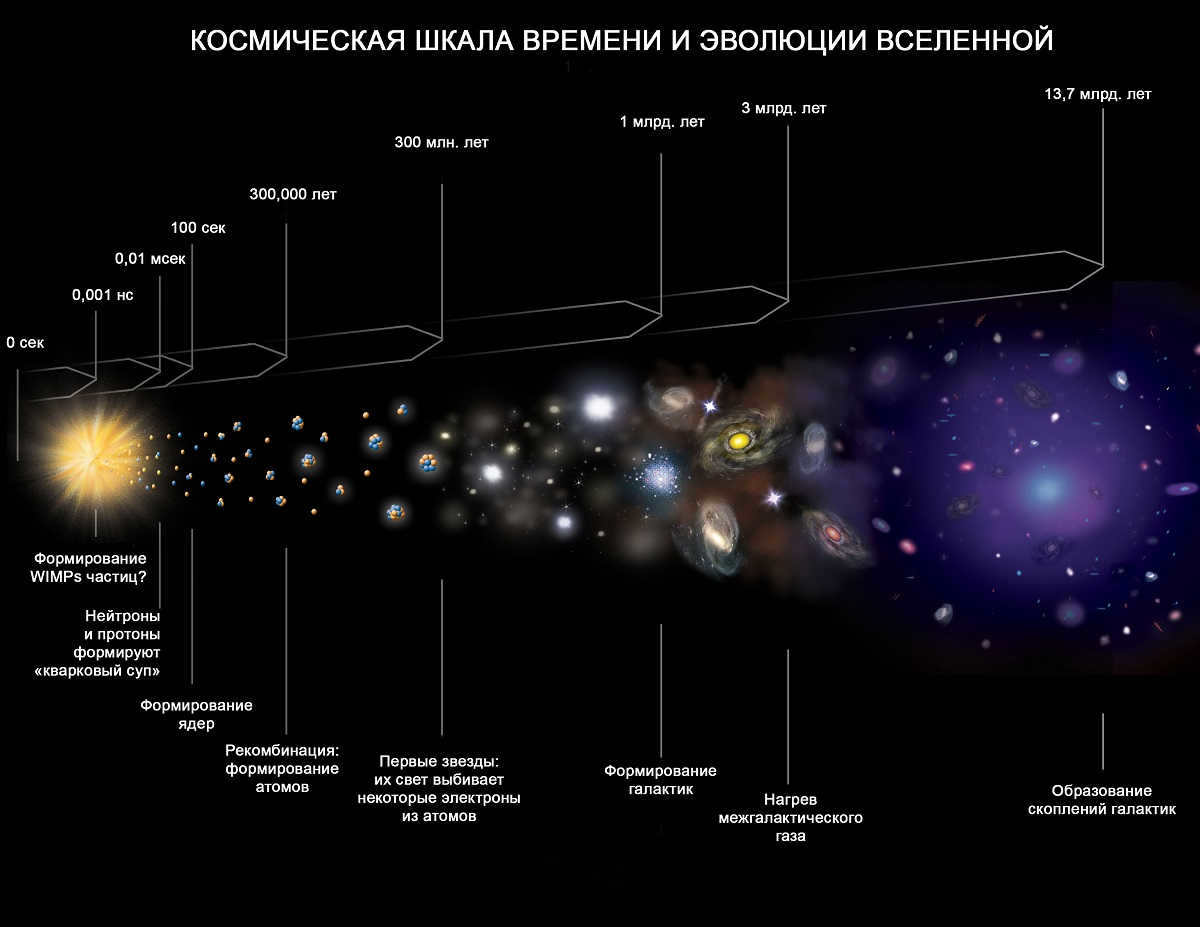
The evolution of the Universe and the cosmic time scale can be explained by the sequence of events that led to the formation of cosmic objects.
Initially, all matter existed in a single massive nuclear blob composed of particles and antiparticles known as hadrons (protons and neutrons). The ratio of particles to antiparticles was approximately 1:1.1. Subsequently, a process of annihilation occurred, resulting in the elimination of particles and antiparticles. The remaining protons and neutrons served as the building blocks for the formation of the Universe. This period, known as the hadronic era, lasted for an extremely short duration of 0.0001 seconds, corresponding to the explosive reaction.
Following 100 seconds, the synthesis of elements commences. At a staggering temperature of one billion degrees, hydrogen and helium molecules materialize through nuclear fusion. Simultaneously, matter continues to expand throughout space.
From this moment, a protracted stage of nuclei and electron recombination ensues, lasting anywhere from 300,000 to 700,000 years, resulting in the formation of hydrogen and helium atoms. The temperature of matter decreases, and the radiation intensity diminishes. The universe becomes transparent. The immense gravitational forces cause the abundant formation of hydrogen and helium, transforming the early Universe into an expansive construction site. After millions of years, the stellar era commences, marking the process of protostar and protogalaxy formation.
The classification of evolution into different stages is compatible with the theory of the expanding Universe, which provides explanations for numerous phenomena. However, the actual triggers of the Big Bang and the mechanisms behind the expansion of matter are still shrouded in mystery.
The Composition and Organization of the Universe
The stellar era of the Universe’s evolution begins with the emergence of hydrogen gas. Under the force of gravity, hydrogen clusters and clumps together, forming enormous masses with densities hundreds of thousands of times greater than that of the resulting galaxy. The uneven distribution of hydrogen during the early stages of the universe’s formation accounts for the variations in the sizes of galaxies. Megalaxies formed in areas where hydrogen gas accumulated to its maximum extent, while regions with lower hydrogen concentrations gave rise to smaller galaxies like our own Milky Way.
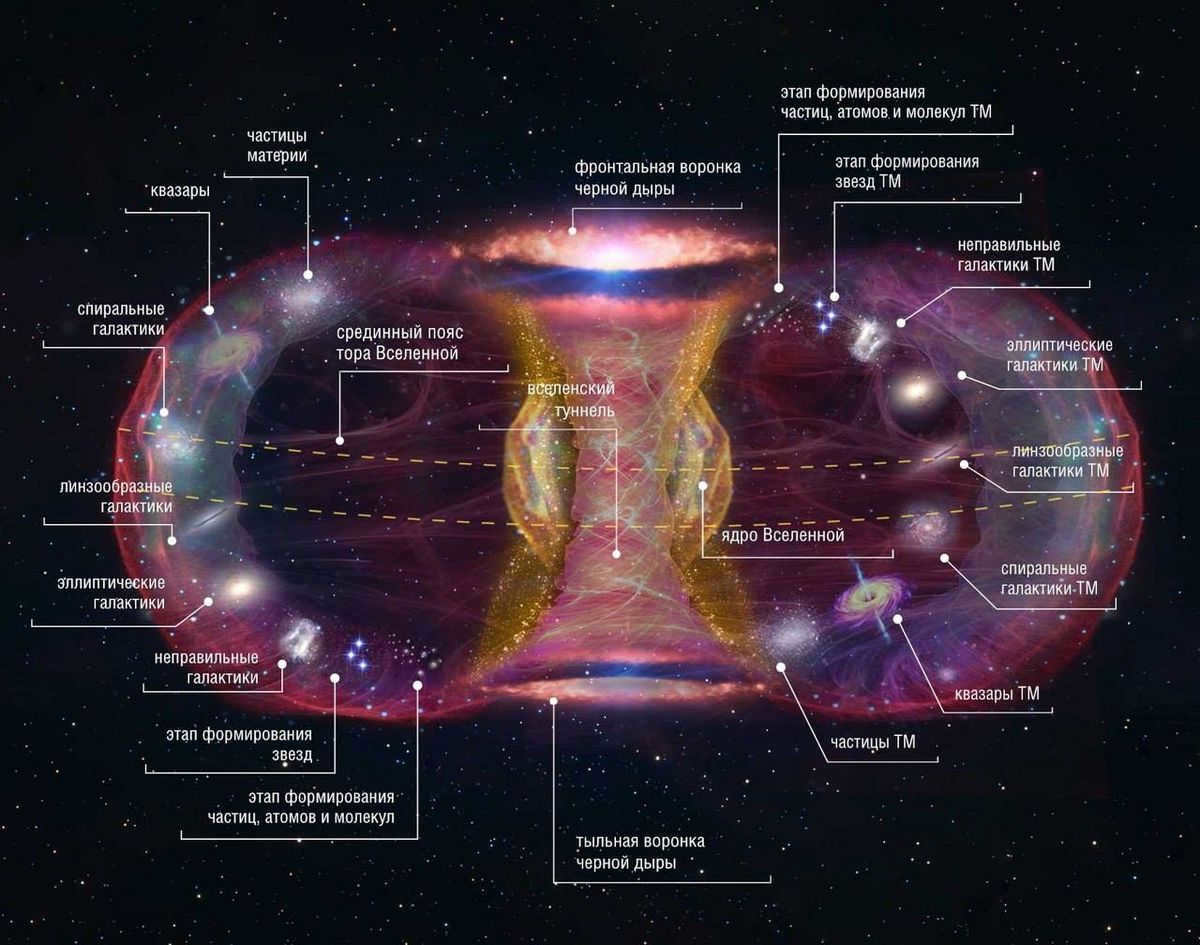
According to one theory, the Universe is a central point from which galaxies of different stages of development orbit.
At this central point, the Universe is formed with distinct boundaries and physical parameters. These formations are no longer in the form of nebulae or clusters of gases and dust, but rather are the early formations of stellar matter. These stellar systems are vast and fascinating, beyond human comprehension. The Universe becomes filled with captivating cosmic phenomena.
According to the current scientific model of the universe, galaxies initially formed due to the forces of gravity. This led to the conversion of matter into a massive celestial vortex. Subsequently, centripetal mechanisms caused the fragmentation of gas clouds into clusters, which served as the birthplace for the first stars. Over time, protogalaxies with a rapid rotation period evolved into spiral galaxies. In cases where the rotation was slow and matter compression was predominant, irregular galaxies, often in the form of ellipses, emerged. Simultaneously, more spectacular phenomena occurred in the cosmos, such as the formation of galaxy superclusters, where the edges of different galaxies come into close contact with each other.
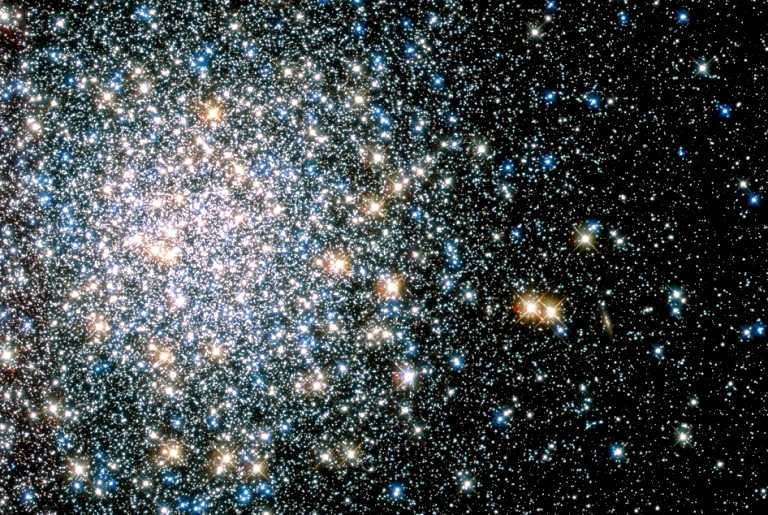
Superscopes are numerous assemblages of galaxies and galaxy clusters within the vast structure of the Universe. There are approximately 100 superscopes located within 1 billion sv years of each other.
From this juncture forward, it became evident that the Universe is an immense map, where the continents are galaxy clusters and the countries are megalaxies and galaxies formed billions of years ago. Each of these formations is composed of star clusters, nebulae, and clusters of interstellar gas and dust. However, this entire population constitutes only 1% of the total volume of universal formations. The primary mass and volume of galaxies are occupied by dark matter, the nature of which cannot be elucidated.
The variety of the Universe: types of galaxies
Thanks to the dedication of American astrophysicist Edwin Hubble, we now possess the limits of the Universe and a distinct categorization of the galaxies residing within it. This categorization is rooted in the unique characteristics of these colossal formations. What accounts for the diverse shapes of galaxies? The Hubble classification provides the answer to this and numerous other inquiries, delineating the Universe into the following classes of galaxies:
The initial group consists of the most prevalent structures that populate the cosmos. The distinguishing characteristics of spiral galaxies are their possession of a clearly defined spiral structure that either encircles a luminous core or stretches towards the galactic hub. Spiral galaxies with a core are designated by the symbol S, whereas those with a central hub are designated by SB. Our very own Milky Way galaxy, which features a core separated by a luminous hub, falls into this category.
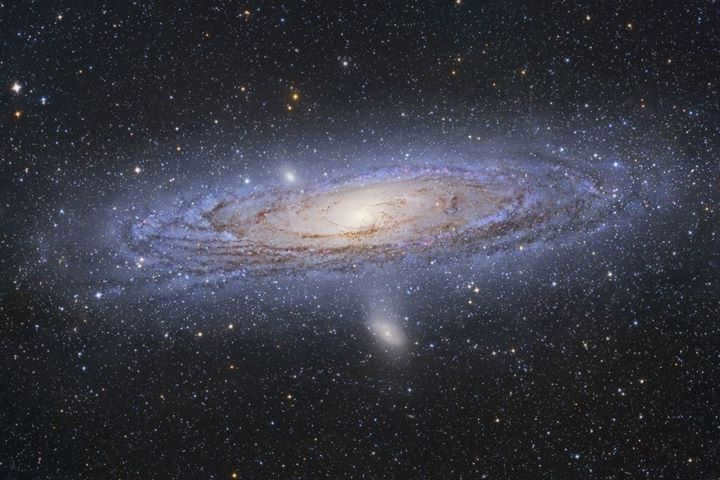
The Milky Way Galaxy is a typical spiral galaxy. It has a clearly visible core with spiral arms radiating from its ends.
Similar structures can be found throughout the entire Universe. The Andromeda galaxy, which is the closest spiral galaxy to us, is a giant that is rapidly approaching the Milky Way. The largest known spiral galaxy is NGC 6872, with a galactic disk diameter of approximately 522,000 light-years. This massive object is located 212 million light-years away from our galaxy.
One example of this category that has been documented is the elliptical ring nebula situated in the Lyra constellation. This celestial body can be found 2100 light years away from our planet.
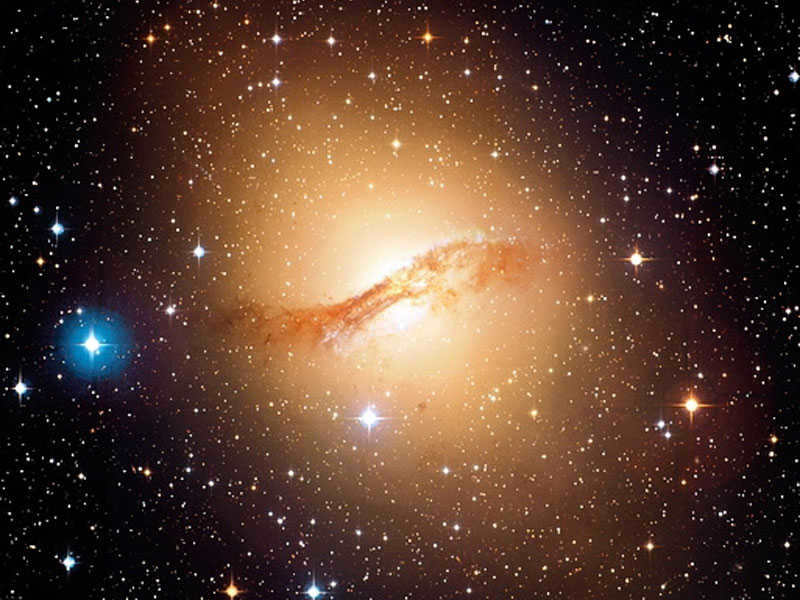
The elliptical galaxy Centaurus A can be observed through the CFHT telescope.
The final category of galactic entities found in the Universe is irregular or irregular galaxies. These galaxies are labeled with the Latin symbol I in the Hubble classification system. Their defining characteristic is their irregular shape. In other words, they lack symmetrical shapes and have a unique pattern. These galaxies resemble a depiction of universal chaos, with clusters of stars interspersed with clouds of gas and cosmic dust. Irregular galaxies are a common occurrence on a universal scale.
Irregular galaxies can be further classified into two subtypes:
- Irregular galaxies of type I exhibit a complex and irregular structure, with a high surface density that is characterized by its brightness. The irregular shape of these galaxies is often a result of collapsed spiral formations. The Large and Small Magellanic Clouds are prime examples of such galaxies;
- Irregular galaxies of type II, on the other hand, have a lower surface brightness and a chaotic shape. These formations are not characterized by high brightness, making them harder to detect in the vastness of the Universe.
The Large Magellanic Cloud is the closest irregular galaxy to us. Both of these formations are satellites of the Milky Way and may eventually be absorbed by a larger object in the next 1-2 billion years.
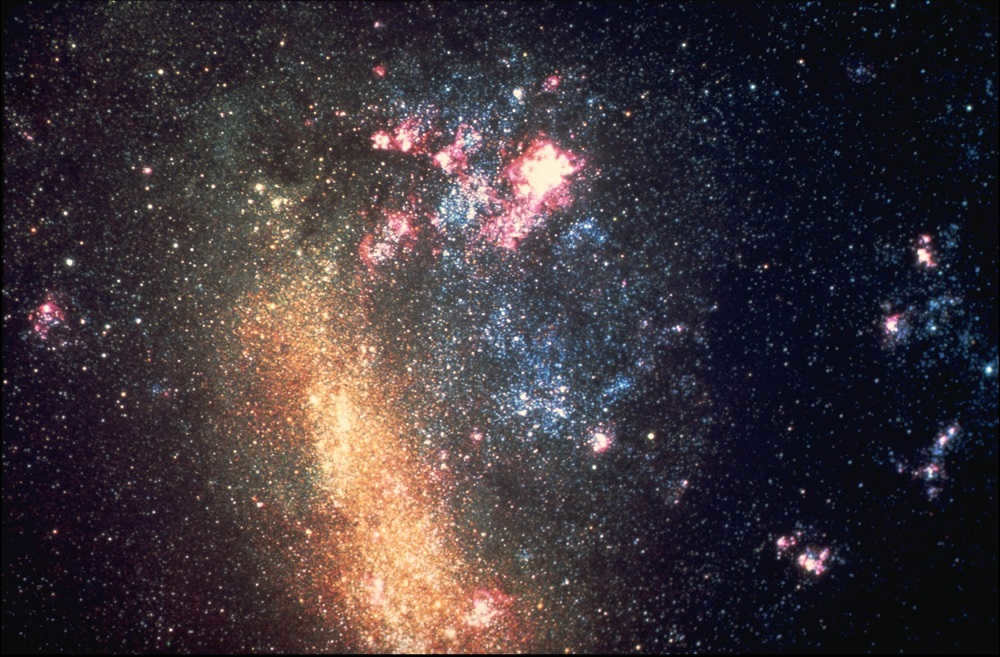
The Large Magellanic Cloud is a type of irregular galaxy that orbits our Milky Way galaxy.
Although Edwin Hubble’s classification of galaxies is quite accurate, it is not flawless. By incorporating Einstein’s theory of relativity into our understanding of the Universe, we can potentially discover even more about its various forms and structures. The Universe is filled with a vast array of unique properties and features. Recently, astronomers have made exciting discoveries of new galaxy formations that can be described as intermediate objects between spiral and elliptical galaxies.
The Milky Way is widely recognized as the most familiar region of the cosmos
Comprising of two symmetrical spiral branches encircling the core, the primary body of the galaxy is formed. These spirals consist of arms that seamlessly merge into one another. Our Sun is situated at the intersection of the Sagittarius and Swan arms, positioned approximately 2.62-10¹⁷km away from the center of the Milky Way. The spirals and arms of spiral galaxies are conglomerations of stars, with their density increasing as they approach the galactic center. The remaining mass and volume of galactic spirals predominantly consist of dark matter, with interstellar gas and cosmic dust constituting only a small fraction.

The location of the Sun within the arms of the Milky Way, our galaxy’s position within the vast expanse of the Universe.
The width of the spirals measures approximately 2 thousand light years. This entire layered structure remains in constant motion, spinning at an incredible velocity of 200-300 km/s. As one moves closer to the center of the galaxy, the rotational speed increases. It would take the Sun and our solar system a span of 250 million years to complete a full orbit around the central region of the Milky Way.
The Milky Way consists of one trillion stars, varying in size from large to small, and ranging from superheavy to medium-sized. The Sagittarius arm is the most densely populated cluster of stars in our galaxy, and it is in this area that we observe the highest level of brightness. Conversely, the opposite side of the galactic circle is less bright and less visually distinguishable during observations.
The nucleus of the Milky Way, estimated to be 1000-2000 parsecs in size, serves as the central region of the galaxy. This area boasts the highest concentration of stars, each with their own unique classifications, developmental paths, and evolutionary processes. Most of these stars are elderly, supermassive stars in the final stages of the Main Sequence. The presence of numerous neutron stars and black holes in this region serves as evidence of the aging center of the Milky Way galaxy. Indeed, at the center of every spiral galaxy’s spiral disk lies a supermassive black hole, which acts as a colossal vacuum, gradually drawing in celestial objects and matter.
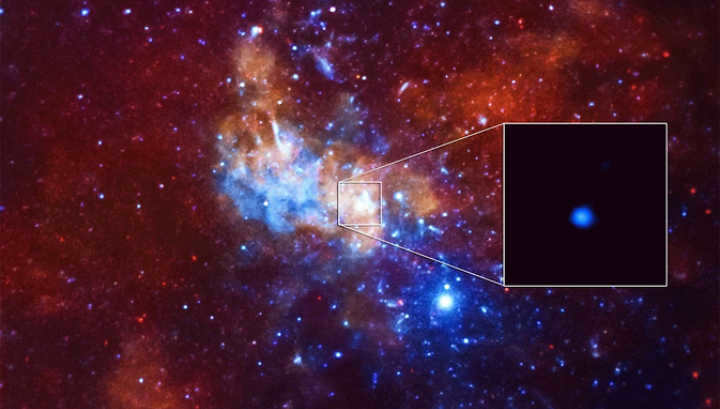
The central region of the Milky Way harbors a supermassive black hole, which serves as the ultimate demise for all celestial entities within our galaxy.
This vast universe is the home of our solar system. We are not alone in this expansive world. Many stars, like the Sun, have their own planetary systems. The challenge lies in detecting distant planets, especially when the distances within our own galaxy surpass the lifespan of any intelligent civilization. The measurement of time in the universe is based on different criteria. Planets, along with their moons, are the smallest entities in the Universe. The number of such objects is immeasurable. Each of the stars within our visible range may have their own systems of planets. However, we can only observe the closest planets to us. The mysteries of what lies beyond, the worlds in other parts of the Milky Way, and the planets in other galaxies remain unknown.
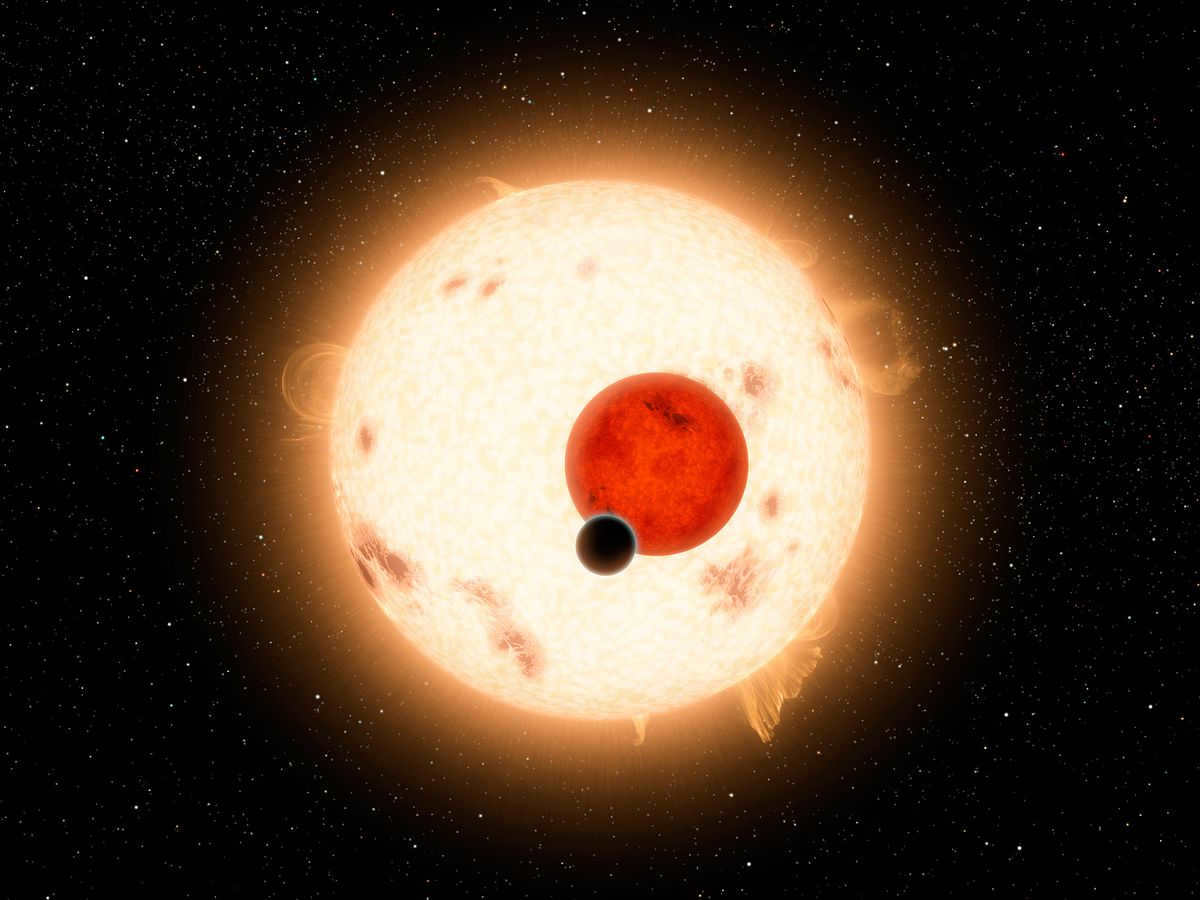
Kepler-16 b is an exoplanet located in the binary star system Kepler-16 in the constellation Cygnus.
Summary
With only a limited understanding of the origins and evolution of the Universe, humanity has only scratched the surface of comprehending the vastness and complexity of the cosmos. The immense size and scope that scientists grapple with today suggests that human civilization is but a fleeting moment in the grand tapestry of matter, space, and time.
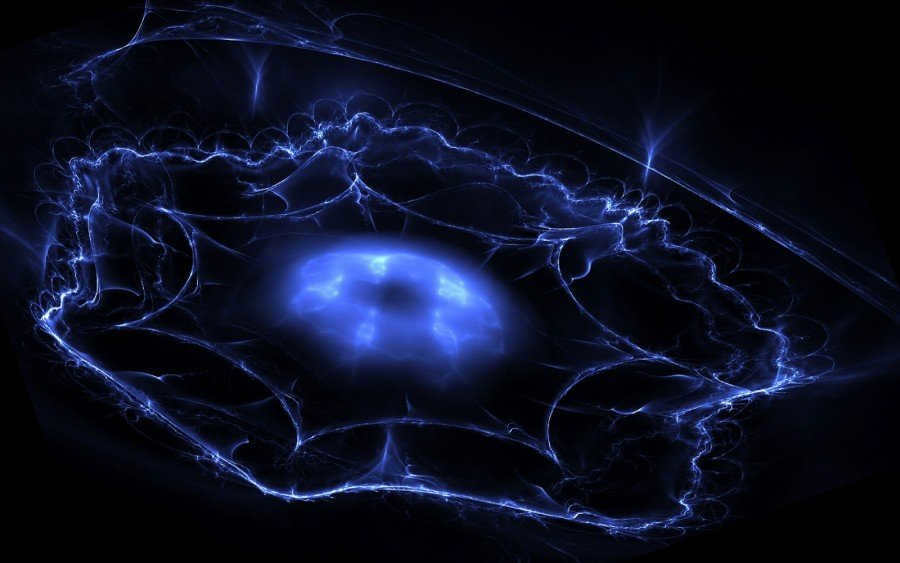

An illustration of the cosmos based on the concept of the existence of substances in the vastness of space over the course of time
The exploration of the cosmos spans from the time of Copernicus to the present. Initially, scientists adopted the heliocentric model, but it was soon discovered that the universe lacks a definitive center and all motion and rotation follow the laws of the cosmos. Despite our ability to explain these processes scientifically, celestial objects are classified into various classes, species, and types, with no two bodies in the universe being identical. The sizes and masses of these celestial bodies are only approximations, and the arrangement of galaxies, stars, and planets remains tentative. This is due to the absence of a universal coordinate system in the universe. When observing the cosmos, we project our observations onto the entire visible horizon, using Earth as our reference point. In reality, we are merely minuscule particles adrift in the boundless expanse of the universe.
